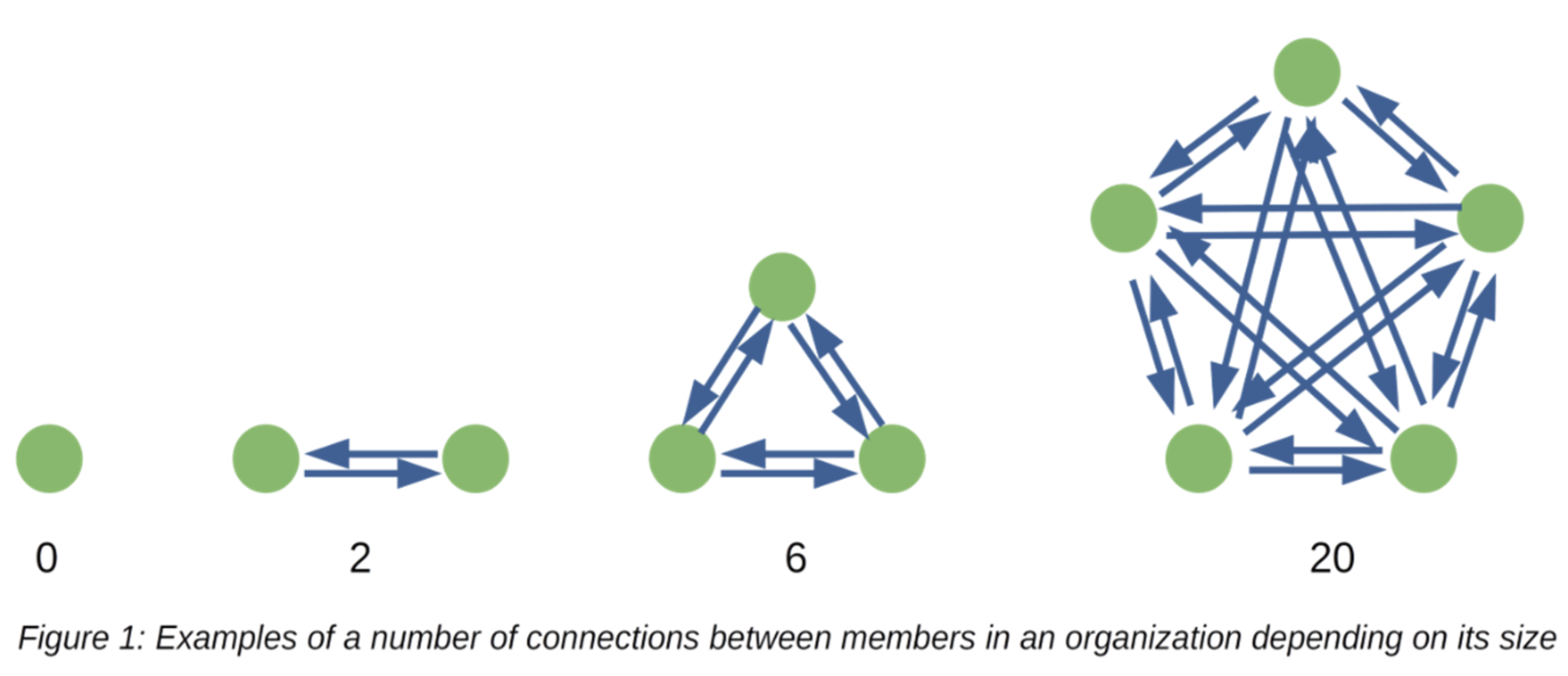This article was originally published in the blog of Copernicus Accelerator by SpaceTec Partners, Verhaert, and the Copernicus Earth satellite observation programme of European Union.
Building a start-up means building an organisation which seeks to extract revenues from some market.
All organisations consist of people. Communication between people in an organisation takes time. The more people join the communication line, the more time it takes to convey a piece of information between all of them1.
In a bigger organisation, communication could easily take so much time that it will reach the natural limit of human ability. Conveying a message within a group of people could take more time than what the coordinator of the group can afford to spend. Moreover, it can take so long that by the time the message is conveyed to all recipients, the information in the message will be irrelevant or obsolete.
These Human Communication Costs define the limit of how much work can be done when building an organisation as a hierarchical structure2. It is also true for a horizontally organised group of people communicating with each other without a manager.

When building an organisation, a project owner (start-up founder, CEO) risks ending up just communicating and nothing else. In fact, that is how most organisations are built. A project owner’s job could be just to hold meetings all day long.
But from all these appointments, what would be the most efficient company meeting from the Human Communication Costs perspective? It is the meeting in the project owner’s mind where they meet with themselves3.
On the other side, we have the employees and contractors of the company, who – unlike the project owner – possess all the necessary information to implement their tasks.
This is called “the agency dilemma” and because of it there is no guarantee that the CEO’s thoughts and orders will be implemented correctly or on time4. Likewise, there is no assurance that those orders will be relevant or correct.
Now let us remember that there are many business tasks that have already been automated at least partially (especially in the web context), such as marketing (content planning, scheduling, and posting), advertising (bidding and publishing), helpdesk support activities, and the product itself (any software-as-a-service).
The concept of automating a business is not new. However, the idea of automating the process of building an organisation (I call it “computer-aided organisation building”, CAOB) could help avoid Human Communication Costs from the start. With CAOB a project owner can preserve more of their most valuable resource – time.
Moreover, with the support of automation tools, the project owner can mitigate the risks of agency dilemma because any tool – unlike a human – will do exactly what it has been instructed to do.
What does this have to do with start-up funding? To answer this question, I will pose two more questions:
- Do you have tasks in your business plan that you could implement yourself faster than the time it takes to delegate it to someone (create a task specification > communicate the specification > follow the implementation > validate the results)?
- Do you have any tasks in your business plan that could be implemented with automation software?
If the answer to any of those questions is “yes”, then at least for those tasks you do not need funding. You can start implementing them right now.
You could spend all your time searching for funding just to cover your start-up’s Human Communication Costs. How about using computer-aided organisation building to turn your start-up into a business (instead of after getting funded)?
Your startup’s launch is closer than you might think! Good luck.
1: Wikipedia. Complete Graph Properties – https://en.wikipedia.org/wiki/Complete_graph#Properties. Retrieved 2021-09-09. ↩
2: Frederick P. Brooks, Jr. The Mythical Man-Month. 1995 [1975]. Addison-Wesley. ↩
3: Cliff Harris. Communication. The secret weapon of one-person companies. https://web.archive.org/web/20210116090137/https://www.positech.co.uk/cliffsblog/2020/10/17/communication-the-secret-weapon-of-one-person-companies/. Retrieved 2021-09-09. ↩
4: Wikipedia. Principal–agent problem – https://en.wikipedia.org/wiki/Principal%E2%80%93agent_problem. Retrieved 2021-09-09. ↩
